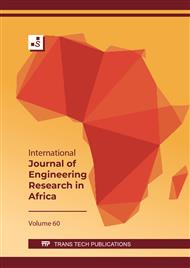[1]
A.Suaila, I. M. Idris, M.Yupiter, Weld defect Features Extraction on Digital Radiographic Image using Chan-Vese Model, IEEE 9th International Colloquim on signal and its Application, Kuala Lumpur, Malaysia, (2013) 67-72.
DOI: 10.1109/cspa.2013.6530016
Google Scholar
[2]
M.Sundaram, J.Prabin, G.Jaffino, Weld in Defects Extraction for radiographic images using C-means segmentation method, IEEE International conference on communication and network technologies, Sivakasi, India, (2014) 79-83.
DOI: 10.1109/cnt.2014.7062729
Google Scholar
[3]
N. Chetih, N. Ramou, Z .Messali A.Serir, Y. Boutiche, Micrographic image segmentation using level set model based on possibilistic C-Means clustering, IEEE European conference on electrical engineering and computer science, Bern, Switzerland, (2017) 188-192.
DOI: 10.1109/eecs.2017.43
Google Scholar
[4]
Y. Boutiche, Local segmentation via an implicit region-based deformable model applied to weld defects extraction, International Journal of Computer and Information Technology. 2(4) (2013) 815-820.
Google Scholar
[5]
N. Ramou, Segmentation of Weld Defects Using Multiphase Level Set by the Piecewise-Smooth Mumford-Shah Model, Russian Journal of Nondestructive Testing. 55(2) (2019) 155–161.
DOI: 10.1134/s1061830919020074
Google Scholar
[6]
E Yahaghi, The detection of weld defect images using shape-from-shading and wavelet denoising methods, Insight-Non-Destructive Testing and Condition Monitoring. 56(6) (2014) 308-311.
DOI: 10.1784/insi.2014.56.6.308
Google Scholar
[7]
E. Yahaghi, M. Mirzapour, A. Movafeghi, B. Rokrok, Interlaced bilateral filtering and wavelet thresholding for flaw detection in the radiography of weldments, Eur. Phys. J. Plus 135, 42 (2020).
DOI: 10.1140/epjp/s13360-020-00119-y
Google Scholar
[8]
H. Jiang, R. Wang, Z. Gao, J. Gao, H. Wang, Classification of weld defects based on the analytical hierarchy process and Dempster–Shafer evidence theory. J Intell Manuf 30 (4) (2019) 2013–(2024).
DOI: 10.1007/s10845-017-1369-4
Google Scholar
[9]
H. Zhu, W. Ge, Z Liu, Deep Learning-Based Classification of Weld Surface Defects, Appl. Sci., 9 (16) (2019) 3312.
Google Scholar
[10]
J. Zapata, R. Vilar, R. Ruiz, Performance evaluation of an automatic inspection system of weld defects in radiographic images based on neuro-classifiers, Expert Syst. Appl. 38(7) (2011) 8812–8824.
DOI: 10.1016/j.eswa.2011.01.092
Google Scholar
[11]
J. Kumar, R.S. Anand, S.P. Srivastava, Flaws classification using ANN for radiographic weld images, IEEE International Conference on Signal Processing and Integrated Networks (SPIN), Noida, India, (2014)145-150.
DOI: 10.1109/spin.2014.6776938
Google Scholar
[12]
R. Vilar, J. Zapata, R. Ruiz, An automatic system of classification of weld defects in radiographic images, NDT E International. 42(5) (2009) 467–476.
DOI: 10.1016/j.ndteint.2009.02.004
Google Scholar
[13]
M.Barstugan, Y.S. Ceran, M. Yilmaz and N.A. Dundar, Detection of Defects on Single-Bead Welding by Machine Learning Methods, IOP Conference Series: Materials Science and Engineering 895(1) (2020).
DOI: 10.1088/1757-899x/895/1/012012
Google Scholar
[14]
W. Khalifa, O. Abouelatta, E. Gadelmawla, I. Elewa, Classification of Welding Defects Using Gray Level Histogram Techniques via Neural Network, Mansoura Engineering Journal. 39(4) (2014) 1-13.
DOI: 10.21608/bfemu.2020.102839
Google Scholar
[15]
D. Mery, M. A. Berti, Automatic detection of welding defects using texture features, Insight-Non-Destructive Testing and Condition Monitoring 45(10) (2003) 676-681.
DOI: 10.1784/insi.45.10.676.52952
Google Scholar
[16]
D. Mery, R.R. da Silva, L.P. Calôba, and J. Rebello, Pattern recognition in the automatic inspection of aluminum castings, In Insight-Non-Destructive Testing and Condition Monitoring, 45 (7) (2003) 475-483.
DOI: 10.1784/insi.45.7.475.54452
Google Scholar
[17]
J. Fang, K. Wang, Weld Pool Image Segmentation of Hump Formation Based on Fuzzy C-Means and Chan-Vese Model, J. of Materi Eng and Perform. 28 (2019) 4467–4476.
DOI: 10.1007/s11665-019-04168-y
Google Scholar
[18]
H. Pan, W. Liu, L. Li, G. Zhou, A novel level set approach for image segmentation with landmark constraints, Optik. 182 (2019) 257–268.
DOI: 10.1016/j.ijleo.2019.01.009
Google Scholar
[19]
T. Chan, L. Vese, An Active Contour Model without Edges, IEEE Trans. Image Processing. 10 (2) (2001) 266-277.
DOI: 10.1109/83.902291
Google Scholar
[20]
L.A. Vese, T.F. Chan, A Multiphase Level Set Framework for Image Segmentation Using the Mumford–Shah Model, International Journal of Computer Vision 50(3) (2002) 271-293.
Google Scholar
[21]
D. Mumford, J. Shah, Optimal approximations by piecewise smooth functions and associated variational problems, Communications on Pure and Applied Mathematics. 42(5) (1989) 577-685.
DOI: 10.1002/cpa.3160420503
Google Scholar
[22]
G. Chang, B. Yu, and M. Vetterli, Adaptive wavelet thresholding for image denoising and compression, IEEE Trans. Image Process. 9 (9) (2000) 1532–1546.
DOI: 10.1109/83.862633
Google Scholar
[23]
J. C. Dunn, A Fuzzy Relative of the ISODATA Process and its Use in Detecting Compact Well-Separated Clusters, Journal of Cybernetics 3(3) (1973) 32-57.
DOI: 10.1080/01969727308546046
Google Scholar
[24]
J.C. Bezdek, Objective function clustering, in Pattern recognition with fuzzy objective function algorithms, Springer, Boston, MA, 1981, pp.43-93.
DOI: 10.1007/978-1-4757-0450-1_3
Google Scholar
[25]
Information on https://domingomery.ing.puc.cl/material/gdxray/.
Google Scholar
[26]
N.D.H. Thanh, D. Sergey, V.B.S. Prasath, N.H. Hai, Blood vessels Segmentation method for retinal fundus images based on adaptive principal curvature and image derivative operators, International Archives of the Photogrammetry, Remote Sensing & Spatial Information Sciences, Moscow, Russia (2019).
DOI: 10.5194/isprs-archives-xlii-2-w12-211-2019
Google Scholar
[27]
G. Csurka, D. Larlus, F. Perronnin, and F. Meylan, What is a good evaluation measure for semantic segmentation?, BMVC, 27 (2013).
DOI: 10.5244/c.27.32
Google Scholar


